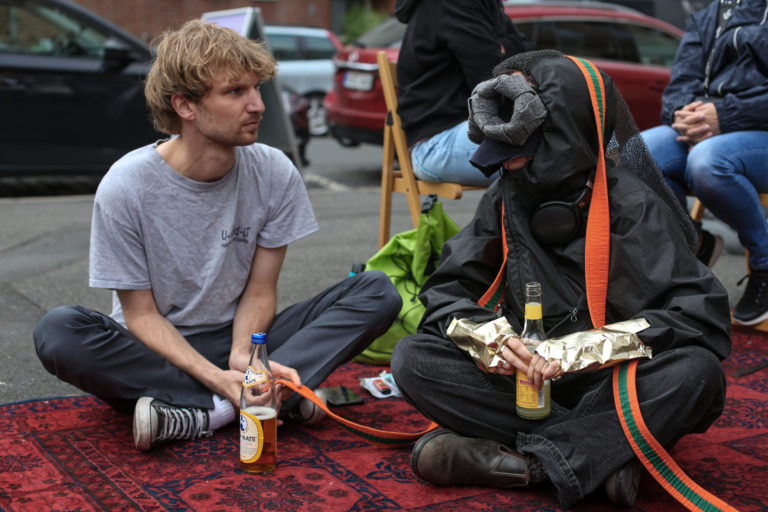Artistic research in response to multiple crises
Date: 2024 / 25
Location: Hannover, Germany
Organization: TANKE e.V., project space
Role: Initiator, curator, space design
Project Team: Sofia Baronner (curator, head of TANKE e.V.), Simon Schirmer (curator, graphic design, space design), Lucia Schoppenhorst (curator, space design), Sarah Nicola (curator, space design), Josephine Altmeyer (curator), Endric Merker (curator, IT, organization), Mel Wilken (producer, space design)
Collaborators: Stiftung Leben & Umwelt / Heinrich-Böll-Stiftung Niedersachsen
Supporters: Stadt Hannover, Region Hannover, Bezirksrat Hannover Südstadt-Bult

The year-long project ‘Home Repair’ is inspired by Richard Powers’ novel ‘The Overstory’, which addresses environmental protection and activism in multi-dimensional ways. We take up this theme and examine the challenges of living together in times of multiple crises from interdisciplinary perspectives – both in an ecological and social context. We use the term ‘Home’ as a metaphor to establish new approaches to the current societal discourse. ‘Repair’ is understood by us as a low-threshold entry into action, as self-empowerment to generate positive dynamics. The aim is to think and create positive visions through encounters with art. We seek for new perspectives through artistic research, knowledge creation through artistic practice. Beyond traditional exhibition formats, we pursue an open approach with workshops, excursions and lecture performances. We involve local partner organizations as well as public spaces. Our core questions are: What does it mean for us to live in a damaged home? What can be repaired and what can we do ourselves? How can we learn from approaches outside Western perspectives and anthropocentric worldviews?
Experimenting, exchanging and learning through artistic practice
threat threats, Suna Yoo
Colorado, Julia Mensch
Julia Mensch (based in Berlin and Buenos Aires) explores the amaranth plant as a political actor in the conflict around soybean monoculture in South America. Glyphosate, a powerful herbicide, is used in combination with resistant seeds. Monocultures are established on clear cut rainforest lands, leading to catastrophic consequences for the climate, biodiversity, peasants and indigenous communities. Amaranth, also named kiwicha or yuyo colorado withstands the toxic treatment. Its resilience has gained symbolic power that inspired political resistance. Its seeds were preserved by indigenous peoples, despite the Spanish colonizers’ prohibition. Julia Mensch calls amaranth America’s revenge, relating to the scientist and environmental activist Andrés Carrasco. Through her artistic research approach using drawings, observation and interviews, the artist explores the perspective of the plant and its active role in both local and global contexts.
Colorado (part of Amaranth. Plants as Political Agents in Colonized America) by Julia Mensch is realized within the framework of “Plants_Intelligence. Learning Like a Plant” (2022–2025), funded by the SNF and hosted by the IAGN HGK at the Basel Academy of Art and Design FHNW.
The Dying River, Jonas Kakó
Cohabitat, Franziska Klose
Franziska Klose (Leipzig) puts on a selective gaze for the urban environment as home for our fellow critters who live from photosynthesis. In her ongoing project Cohabitat, the artist is fascinated by the question how to understand cities as living environments for plants that have developed their own modes of surviving and thriving in the cracks and nieces, front yards and alleyways, parks, balconies, walls, roadsides etc. Taken forward, this perspective leads to the idea, that human urban inhabitants may in some respect be hosts whom the green population has long learned to live from. Franziska’s question strikingly relates to a key notion of the Home Repair series, inspired by Richard Powers’ novel The Overstory. One of the main characters in the book declared: “This is not our world with trees in it. It’s a world of trees, where humans have just arrived.” Franziska Klose works with the medium of photography. As an art space in an urban setting, we aimed to borrow her lens to create a direct experience in exchange with our surrounding. At TANKE, Franziska led a selective, sensual and speculative excursion in our neighborhood. Guided by the artist, we sneeked into the world of shrubs, trees, flowers edible and decorative plants that virtuously populate the environment that humans often tend to think of as their own.
Jessica Pavone (New York) offers an excursion on the thematic fringes of our annual project Home Repair. The classically trained violist has forged her own path in experimental jazz and new music. She creates sounds as a direct and physical experience, something that, in a literal sense, moves and connects us. Jessica lives in New York where she has established herself in the scene of new music. We are delighted, having been able to host her in Hannover, thanks to a cooperation with the club ausland in Berlin.




























